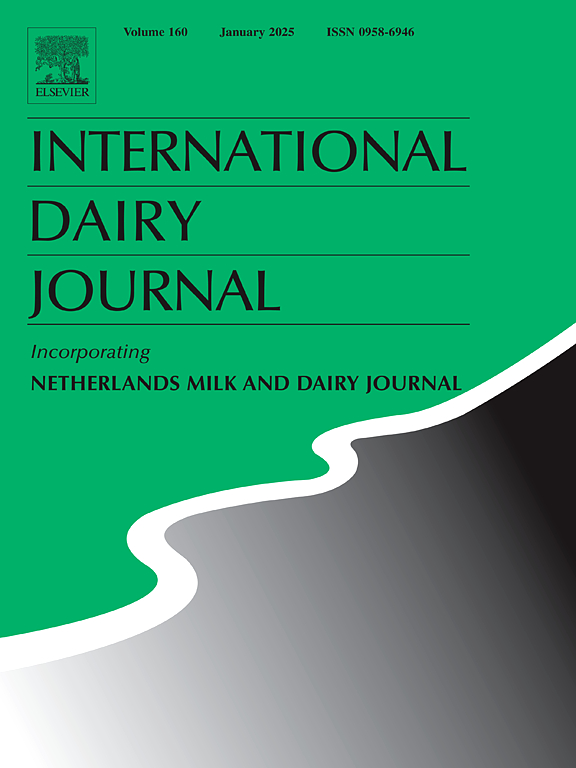Influence of UV-C radiation on the treatment of Minas Frescal cheese inoculated with Escherichia coli and Staphylococcus aureus
IF 3.4
3区 农林科学
Q2 FOOD SCIENCE & TECHNOLOGY
引用次数: 0
Abstract
Short-wave ultraviolet (UV-C) radiation is a non-thermal technology recognised for its antimicrobial effect and lower investment and maintenance costs compared to conventional preservation methods, in addition to the advantages of minimal nutrient loss and non-formation of residual toxic compounds. The aim of this study was to evaluate the effectiveness of UV-C radiation in inactivating E. coli and S. aureus inoculated in sliced Minas Frescal cheese samples. The sensitivity of the microorganisms to UV-C treatment was tested in vitro by subjecting the strains, inoculated in selective culture media, to six different doses (0.037 J/cm2; 0.123 J/cm2; 0.199 J/cm2; 0.263 J/cm2; 0.326 J/cm2; 0.520 J/cm2). All doses tested in vitro increased logarithmic reduction. Dose 6 (0.520 J/cm2) provided a reduction of six logarithmic cycles in both microorganisms tested (6.72 log CFU/g for E. coli and 6.93 log CFU/g for S. aureus). However, the lowest doses with significant difference and relevant logarithmic reduction, dose 3 (0.199 J/cm2) and dose 5 (0.326 J/cm2), were selected for the treatment of the inoculated cheese slices, minimizing possible physicochemical and sensory changes. After UV-C treatment, the cheese slices were stored at 4 °C for 15 days for microbiological analyses. A reduction of one logarithmic cycle was observed at both doses tested for both strains studied (1.1–1.2 log CFU/g for E. coli and 0.89–1.26 log CFU/g for S. aureus). It was concluded that the effect of UV-C light on sliced Minas Frescal cheese, despite its effectiveness in reducing the concentration of E. coli and S. aureus, may be affected by intrinsic factors of the cheese that interfere with the light incidence.
UV-C辐射对接种大肠杆菌和金黄色葡萄球菌的米纳斯奶酪处理效果的影响
短波紫外线(UV-C)辐射是一种非热技术,与传统的保存方法相比,它具有抗菌效果和更低的投资和维护成本,此外还具有最小的营养损失和不形成残留有毒化合物的优点。本研究的目的是评价UV-C辐射对Minas Frescal切片奶酪样品中接种的大肠杆菌和金黄色葡萄球菌的灭活效果。通过将菌株接种于选择性培养基中6种不同剂量(0.037 J/cm2;0.123 J / cm2;0.199 J / cm2;0.263 J / cm2;0.326 J / cm2;0.520 J / cm2)。体外试验的所有剂量都增加了对数还原。剂量6 (0.520 J/cm2)可使两种微生物减少6个对数循环(大肠杆菌为6.72 log CFU/g,金黄色葡萄球菌为6.93 log CFU/g)。然而,接种后的奶酪片选择了最低剂量(剂量3 (0.199 J/cm2)和剂量5 (0.326 J/cm2)处理,且有显著差异和相应的对数减少,最大限度地减少了可能的理化和感官变化。经过UV-C处理后,奶酪片在4°C下保存15天用于微生物分析。两种菌株的剂量均减少一个对数周期(大肠杆菌为1.1-1.2 log CFU/g,金黄色葡萄球菌为0.89-1.26 log CFU/g)。综上所述,UV-C光对Minas Frescal奶酪切片的影响,尽管能有效降低大肠杆菌和金黄色葡萄球菌的浓度,但可能受到奶酪本身因素的影响,这些因素干扰了光线的入射。
本文章由计算机程序翻译,如有差异,请以英文原文为准。
求助全文
约1分钟内获得全文
求助全文
来源期刊

International Dairy Journal
工程技术-食品科技
CiteScore
6.50
自引率
9.70%
发文量
200
审稿时长
49 days
期刊介绍:
The International Dairy Journal publishes significant advancements in dairy science and technology in the form of research articles and critical reviews that are of relevance to the broader international dairy community. Within this scope, research on the science and technology of milk and dairy products and the nutritional and health aspects of dairy foods are included; the journal pays particular attention to applied research and its interface with the dairy industry.
The journal''s coverage includes the following, where directly applicable to dairy science and technology:
• Chemistry and physico-chemical properties of milk constituents
• Microbiology, food safety, enzymology, biotechnology
• Processing and engineering
• Emulsion science, food structure, and texture
• Raw material quality and effect on relevant products
• Flavour and off-flavour development
• Technological functionality and applications of dairy ingredients
• Sensory and consumer sciences
• Nutrition and substantiation of human health implications of milk components or dairy products
International Dairy Journal does not publish papers related to milk production, animal health and other aspects of on-farm milk production unless there is a clear relationship to dairy technology, human health or final product quality.
 求助内容:
求助内容: 应助结果提醒方式:
应助结果提醒方式:


